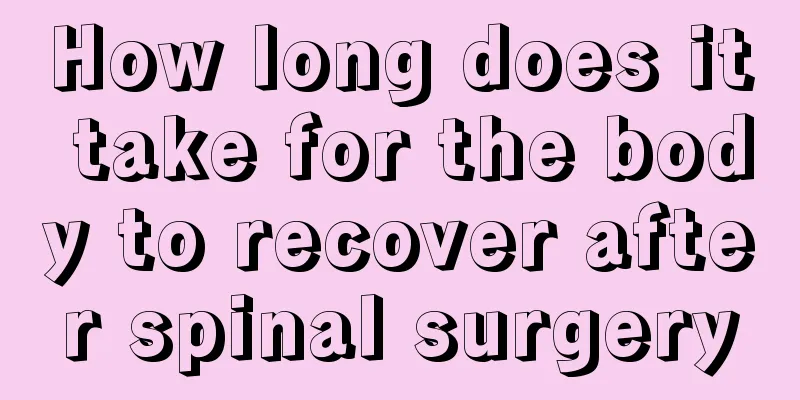How long does it take for the body to recover after spinal surgery

|
The spine is an important part of our body. When the spine is injured, the body will also show some symptoms. If the spinal injury is serious, it may even affect life safety. Many people seek surgical treatment when they have spinal diseases. When patients are going to undergo surgery, they must understand some precautions before and after the surgery. How long does it take to recover after spinal surgery? Generally, patients can be discharged from the hospital in about 7-10 days after surgery without affecting normal activities. At 3-6 months, patients can participate in some non-strenuous sports. When to get up and move after surgery The time it takes for spinal surgery patients to get out of bed mainly depends on factors such as the surgical method, age, and bone condition. a. Patients who have undergone simple fenestration decompression, nucleus pulposus removal and endoscopic discectomy generally need to stay in bed for 2-3 weeks because they do not have internal fixation and need waist protection when walking; b. Patients who have undergone lumbar fusion surgery (internal fixation), if their bones are not particularly porous, generally stay in bed for 1 week, and then gradually get up and move around under the protection of a waist belt; c. Patients who have undergone lateral endoscopic surgery can generally walk on the ground with the protection of the waist belt on the second day after surgery; d. Patients who undergo anterior cervical spine surgery can generally walk after postoperative review (about 3 days after surgery); e. Patients who undergo PKP surgery for osteoporotic fractures in the elderly can generally walk after postoperative follow-up examination (about 2 days after surgery); f. Patients with cervical fractures can generally move around with a brace one week after surgery, and patients with thoracolumbar fractures can generally move around with a brace about 2-3 weeks after surgery. When can I turn over after surgery? Patients after spinal surgery can move their limbs after waking up from anesthesia and returning to the ward, and doctors also encourage patients to actively move their limbs; You can sleep on your back or on your side. When sleeping on your side, the pillow should be at the same height as your shoulder (the neck and shoulder are at 90 degrees), so that your neck will not be twisted and you will feel comfortable. The patient can turn over axially when returning to the ward (the patient's family members protect the patient's head, place their hands on the patient's shoulders and hips, and help the patient turn over). How to perform functional exercises after surgery Functional exercise for patients after spinal surgery follows the principle of "gradual progress, doing what one can, and stopping when one is satisfied". Functional exercise after spinal surgery is very important. Traditional Chinese medicine emphasizes "equal emphasis on tendons and bones." For the spine, "tendons" are equivalent to the muscles, ligaments and other soft tissues around the spine. The spine is a chain of bone joints consisting of vertebrae and intervertebral discs. The spine is the axial bone, and all the organs and tissues in the thoracic and abdominal cavities are "hung" on it. If the muscles and soft tissues around the spine are not well developed and strong enough, the spine itself will be under great pressure. In the long run, the intervertebral disc degeneration will accelerate, leading to disc herniation, intervertebral instability, and nerve compression. Therefore, patients must pay attention to the functional training of the posterior spine muscles. a. All patients can perform straight leg raising exercises on both lower limbs about 3-7 days after surgery; b. It is recommended to start back muscle function training about 4 weeks after surgery. It is recommended to use the five-point support method (supine position, knees flexed, feet, feet, and head). Is adjuvant drug treatment required after surgery? Is there any special diet? a. Diet is determined based on whether or not there are underlying diseases such as hypertension and diabetes. Generally, there are no special taboos, and balanced nutrition is appropriate. No smoking and limited drinking after surgery; b. For patients with severe nerve compression, numbness and discomfort in the limbs, they can take some nerve nourishing drugs, such as Mecobalamin, after surgery; C. For patients with osteoporosis, active anti-osteoporosis treatment is recommended after surgery to prevent re-fracture, loosening of internal fixation, and promote bone fusion. If you have osteoporosis, screws fixed to the vertebrae are like wooden stakes fixed to the beach; if you have non-osteoporotic bones, screws fixed to the vertebrae are like wooden stakes fixed to solid yellow soil, and the strength difference between the two is huge. |
<<: What are the benefits of mung bean, tremella and red dates soup?
>>: What happens if you eat too much spring bamboo shoots
Recommend
Can crabapple flowers be placed indoors?
I believe everyone knows about the crabapple flow...
What are the symptoms of forest encephalitis
Symptoms of forest encephalitis include fever, he...
What are the treatments for wheal?
Wheal is actually called urticaria in daily life....
Pathological morphology of early esophageal cancer
Early esophageal cancer includes carcinoma in sit...
What is the method to adjust the hairline
Adjustment of the hairline mainly refers to when ...
What should you pay attention to if you want to prevent cervical cancer? What are the methods to prevent cervical cancer?
Cervical cancer is a common female disease, mainl...
Endometrial cancer chemotherapy regimen
Many women in life know about the disease of endo...
Pain above the coccyx
If you sit in one place for a long time, you will...
What should I do if I have blisters in my mouth
It is very uncomfortable to have blisters in the ...
What is the cause of the red papules
As the weather gradually gets warmer, there are m...
Which muscles are most likely to be affected by cervical spondylosis
Muscles are the driving force of cervical spine m...
Get up early and look in the mirror to check your health in five places
Certain physical discomforts or precursors of ill...
The dangers of vacuum tire self-refilling
Vacuum tires are also called pneumatic tires. The...
The gold standard for prostate cancer screening
Malignant tumors such as prostate cancer will ser...
Abscess on the buttocks
Many people often have abscess-like things on the...









